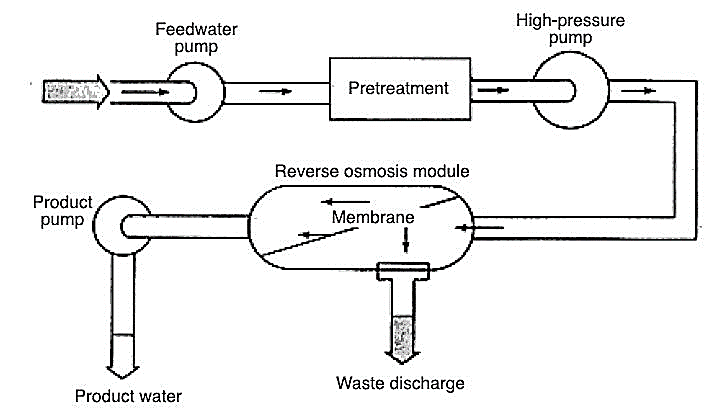
Seawater Desalination with Reverse Osmosis Plant
All Reverse Osmosis crops are generally Desalination Crops but desalination is getting referred to sea h2o normally.As sea water has quite high TDS needs quite superior pressure to power sea drinking water by way of membranes which are distinct then brackish drinking water membranes.
Reverse Osmosis Plant Facts:
A reverse osmosis plant is usually a manufacturing plant, exactly where water is purified and desalinated by forcing water through a membrane, typically called a reverse osmosis method. Drinking water produced by plant RO could be utilized for a number of reasons like desalination, wastewater remedy, along with the reclamation of dissolved minerals.
RO Plant Description
A median drinking h2o RO plant procedure necessitates 6 KW hours of electrical energy to desalinate 1 cubic meter of h2o. Reverse osmosis drinking water plants demands a variety of pre-procedure procedures which include softening, DE chlorination, and anti-scale treatment method. Subsequent pre-treatment, superior levels of pressure send out water via a semi-permeable membrane, which holds all contaminants apart from drinking water.
RO Plant Design
To reinforce the efficiency and lifetime of the Reverse Osmosis plant, successful pretreatment of your feed drinking water is necessary. Variety of the proper pretreatment will optimize efficiency and membrane daily life by decreasing:
Fouling
Scaling
Membrane Degradation
RO plant style and design is consisting of:
Identifying pretreatment prerequisite of Reverse Osmosis Plant
When the feed drinking water has traces of heavy metals, it is extremely encouraged to dose some chlorine to change the dissolved large metals to Actual physical form, the media filter will filter almost all of it inside of a ro water purifier plant.
Reverse Osmosis Plant Variety of membrane
Membrane features are a crucial Component of RO crops. The proteins (mostly polyamide) that makeup membrane factors range depending on the ending clarity and intake water seawater or brackish water and so on
Waterman engineers Australia RO plant for seawater desalination
Waterman Engineers in Australia has made a Reverse Osmosis (RO) plant for seawater desalination, which presents quite a few benefits more than other desalination strategies. Here are several essential advantages of their RO plant:
Strength Effectiveness:
When compared to other desalination approaches like thermal distillation, RO necessitates fewer Electrical power. Waterman Engineers' RO plant makes use of Innovative membrane know-how, letting it to function at reduced pressures and decrease overall energy use.
Environmental Affect:
RO generates significantly less brine discharge in comparison with thermal techniques, reducing the effect on marine ecosystems. This aligns with Australia's focus on environmental sustainability and conservation.
Significant Water Purity:
The RO process proficiently removes salts, minerals, and impurities, developing substantial-high quality freshwater that fulfills stringent drinking drinking water standards. This dependability is crucial for delivering Secure and cleanse water to communities.
Modular Layout:
Waterman Engineers' RO plant employs a modular design, making it possible for for scalability and adaptability. This is particularly beneficial for parts with Desalination Plant Manufacturer varying water calls for, as modules is usually added or modified appropriately.
Lessened Footprint:
RO plants typically Use a lesser physical footprint when compared with thermal desalination vegetation, which frequently involve substantial infrastructure for heating and cooling processes.
Swift Get started-Up and Shutdown:
RO crops can be began and stopped comparatively speedily, letting for improved responsiveness to switching h2o requires and emergencies.
Lower Chemical Utilization:
Compared with some other desalination methods, RO requires much less substances for Procedure and cleaning, minimizing chemical-related environmental concerns.
Regularity in Effectiveness:
The RO course of action is a lot less sensitive to feedwater high quality fluctuations than other methods, making sure a far more steady overall performance over time.
Price tag-Performance:
Although initial financial investment expenditures could be substantial, RO vegetation tend to obtain decrease operational and maintenance expenditures Over time compared to thermal approaches.
Reverse Osmosis (RO) is really a drinking water purification process that works by using a partially permeable membrane to get rid of ions, undesired molecules, and bigger particles from drinking drinking water. By implementing stress to overcome osmotic tension, it permits the passage of drinking water molecules while rejecting contaminants, thereby manufacturing clean water on one particular facet of the membrane and concentrated impurities on another.
The Performing basic principle of a Reverse Osmosis (RO) plant entails making use of force to the saline solution to force water molecules by way of a semi-permeable membrane. This membrane makes it possible for only drinking water to move though rejecting salts, contaminants, and impurities, causing purified h2o on the permeate side along with a concentrated Remedy of contaminants about the brine aspect.
The benefits of Reverse Osmosis incorporate making significant-high-quality, clean up h2o by taking away contaminants, currently being successful and value-successful with time, requiring minimal chemical use, and being adaptable to numerous scales of operation from tiny house methods to substantial municipal vegetation.
RO vegetation have replaced Demineralisation (DM) vegetation given that they typically give a extra effective and price-powerful Answer for h2o purification. RO programs Do not require the regeneration chemical compounds that resin-primarily based DM crops do and may take out a broader variety of contaminants, such as dissolved solids and microorganisms.
Waterman Engineers Australia possible employs Reverse Osmosis (RO) crops for seawater desalination by forcing seawater through a semi-permeable membrane to eliminate salt along with other impurities. This method produces contemporary, potable water through the ocean, addressing h2o scarcity and supplying a sustainable offer for various demands.